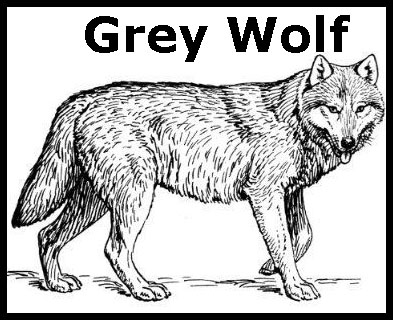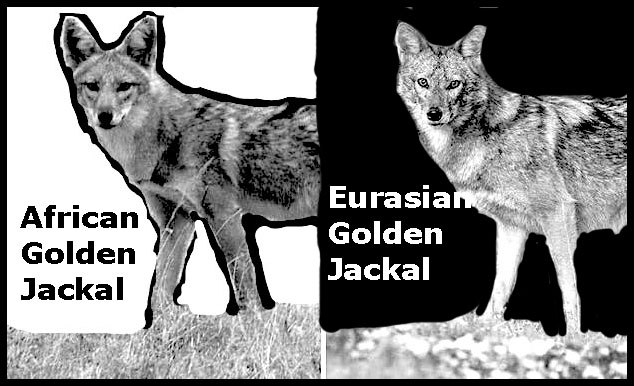Evidence that DNA Changes (3 May 2017, 8 Iyar, 5777)
Contents:
1. A Wolf in Jackals Clothing?
2. Six Similar cases reported by Dr. Fazale Rana
3. Logic and Common Sense versus Evolutionary Theory and DNA Dogma
^^^^^^^^^^^^^^^^^^^^^^^^^^^^^^^^^^^^^^^^^^^^^^^^^^^
1. A Wolf in Jackals Clothing?
Jackals
Jackals and coyotes are considered to belong to the same family. They were considered to be only distantly related to dogs and wolves. Jackals and coyotes share the same way of life as scavengers eating both flesh and vegetable matter. They are distinguished by large feet and fused leg bones give them a physique well-suited for long-distance running, and capable of maintaining speeds for extended periods of time. Different species of jackal share a peculiarity of the teeth that led some authorities to set them apart from other canines.
Wolves

Wolves, on the other hand, are canines of large to medium size that feed primarily on larger mammals, though they also eat smaller animals, livestock, carrion, and garbage. The wolf is different from the jackal in so far as it moves more in packs, eats different food, and is built differently.
Jackals that are Really Wolves according to DNA!

There are African golden jackals and there are Eurasian golden jackals. They look similar, almost the same. Even their coloring is the same. Their teeth and skull shapes are almost the same. But according to DNA they are quite different! One is really a wolf while the other is not. The wolf in question just happened to fit into a similar ecological niche and so he came out looking the same as the other! An article in Current Biology (2015)1 quoted a DNA study.
After exhaustive DNA analyses it was seen that African golden jackals are more closely related to grey wolves, even though there are no grey wolves in Africa and even though grey wolves and African golden jackals look dramatically different.
On the other hand African golden jackals in other respects were not like wolves but rather almost identical to Eurasian golden jackals. The different kinds of 'jackals' were similar due to "amazing morphological convergences" according to Professor Hartstone-Rose.
The African and Eurasian golden jackals had the same skull and tooth morphologies. No differences were found in this respect between the two types. It follows that if DNA is to be believed two bodies may look the same, act the same, have the same skull and teeth shapes, yet be more closely related, not to each other but rather to types that are quite different!
We would propose that the DNA is an effect of the environment!!!
Wolves and jackals might therefore share similar DNA if they were subject tot he same environmental influences.
This suggestion might sound far-fetched at first but read on.
^^^^^^^^^^^^^^^^^^^^^^^^^^^^^^^^^^^^^^^^^^^^^^^^^^^
2. Six Similar cases reported by Dr. Fazale Rana
Repeatable Evolution or Repeated Creation?
http://www.reasons.org/articles/repeatable-evolution-or-repeated-creation
October 1, 2000
By Dr. Fazale Rana
# According to evolutionary theory, organisms that possess identical morphologies (forms or structures) must share a common ancestry. Evolutionary biologists, therefore, have employed morphological systematics, 'the study of the relationships among organisms according to physical characteristics,' when classifying species, and thus have concluded that similar groups share common ancestry. However, with the advent and widespread application of molecular systematics, in which DNA sequences are used instead of morphologies to determine biological relationships, science now is beginning to identify an increasing number of challenges to the evolutionary classification. Biologists are uncovering numerous examples of organisms that cluster together morphologically (structurally), and yet are genetically distinct. Frogs, lizards, or herbs that appear to be identical are actually different at the genetic level. #
The author then gives the following examples:
Six different lizards in the Greater Antilles (Cuba, Hispaniola, Jamaica, and Puerto Rico) that fit six different ecological niches yet morphologically belong tot he same species tested out by mtDNA to be of different origins!
Numerous different species of frogs in Africa and India (e.g. burrowing frogs, tree frogs) that look the same and virtually are the same (even at the larval level) showed through DNA to have different origins.
Similar results were obtained concerning cichids (freshwater fish), mangabey monkeys, river dolphins, Pericallis plants.
^^^^^^^^^^^^^^^^^^^^^^^^^^^^^^^^^^^^^^^^^^^^^^^^^^^
3. Logic and Common Sense versus Evolutionary Theory and DNA Dogma
We, in Brit-Am, are a bit reserved about all this since the descriptions say that mtDNA and general DNA were tested. It has been known for some time that mtDNA is influenced by environment.
Nevertheless, we can extrapolate concerning YDNA.
Taking the case of mangabey monkies, Dr. Fazale Rana says:
# Morphological similarity has traditionally led biologists to place all the mangabey species into a single genus, Cercocebus. Baboons, drills, mandrills, and geladas are closely related to mangabeys. Earlier molecular studies and mitochondrial DNA sequence analysis challenged the morphologically based classification that places mangabeys into a single group.23- 24 These studies indicated that the single mangabey genus should have been separated into two groups, and that the nearly identical mangabey morphologies must have evolved independently two times. Recent nuclear DNA analyses have confirmed that mangabey morphology 'evolved' on two separate occasions, when viewed from the evolutionary paradigm.25 #
Evolutionists might try and explain all these findings by speaking of parallel developments resulting in virtually the same results emanating from different parents.
Previously it was a law of Evolutionary theory that such a phenomenon was impossible. Now this is what they would have to say.
From a Creationist Point of view the Creator could have created the same thing several times over but used different DNA sequences each time.
This is not an impossibility but it is counter-intuitive and illogical.
The logical explanation is that when two monkeys look the same, act the same, live the same, and morphologically are the same, then we can be sure that they are the same, i.e. they belong to the same species.
Their DNA differences are due to each type being in different areas and having their DNA influenced by local factors.
The same applies to humans.
